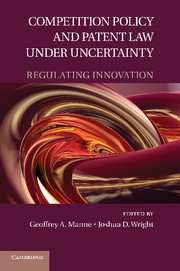Book contents
- Frontmatter
- Contents
- Contributors
- Introduction
- PART I THE INSTITUTIONS OF GROWTH
- PART II THE ECONOMICS OF INNOVATION
- PART III INNOVATION AND COMPETITION POLICY
- PART IV THE PATENT SYSTEM
- 9 Rewarding Innovation Efficiently
- 10 Presume Nothing
- 11 Patent Notice and Cumulative Innovation
- PART V PROPERTY RIGHTS AND THE THEORY OF PATENT LAW
- PART VI INTELLECTUAL PROPRETY AND ANTITRUST: THE REGULATION OF STANDARD-SETTING ORGANIZATIONS
- Index
- References
10 - Presume Nothing
Rethinking Patent Law's Presumption of Validity
Published online by Cambridge University Press: 05 June 2012
- Frontmatter
- Contents
- Contributors
- Introduction
- PART I THE INSTITUTIONS OF GROWTH
- PART II THE ECONOMICS OF INNOVATION
- PART III INNOVATION AND COMPETITION POLICY
- PART IV THE PATENT SYSTEM
- 9 Rewarding Innovation Efficiently
- 10 Presume Nothing
- 11 Patent Notice and Cumulative Innovation
- PART V PROPERTY RIGHTS AND THE THEORY OF PATENT LAW
- PART VI INTELLECTUAL PROPRETY AND ANTITRUST: THE REGULATION OF STANDARD-SETTING ORGANIZATIONS
- Index
- References
Summary
Abstract
The United States Patent and Trademark Office is tasked with the job of reading patent applications and determining which ones qualify for patent protection. It is a herculean task, and the Patent Office pursues it subject to enormous informational and budgetary constraints. Nonetheless, under current law, courts are bound to defer to the Patent Office's decisions regarding patent validity. That is a mistake. Deference to previous decisions is appropriate in instances where those previous decisions have a high likelihood of being accurate. But to grant significant deference to the initial process of patent review is to defer to an unavoidably and significantly inaccurate signal. Put bluntly, early patent review is not reliable and is unlikely to become so. In this chapter, we explain why and propose the creation of a two-tier system of patent validity, with a strong presumption being given to patents after they have been subject to any of a number of intensive review procedures, but only a weak presumption being awarded as a matter of course on patent issuance.
Introduction: The “Bad Patent” Problem
The United States Patent and Trademark Office (PTO) is tasked with the job of reading patent applications and determining which ones qualify for patent protection. It is a herculean task. One problem is resources. About 450,000 patent applicantions are processed annually. As of Fall 2009, there are 1.2 million unexamined applications in the PTO's backlog. To accurately evaluate the merits of all of those purported inventions would cost billions.
- Type
- Chapter
- Information
- Competition Policy and Patent Law under UncertaintyRegulating Innovation, pp. 300 - 330Publisher: Cambridge University PressPrint publication year: 2011



